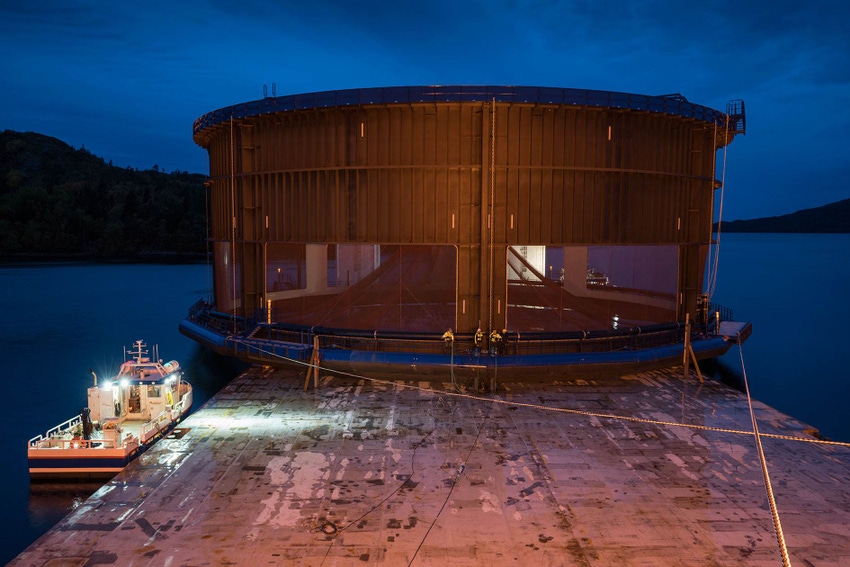New sea cage design draws water from deeper layers where sea lice are less prevalent as well as generates water currents to exercise fish.
January 2, 2019

Researchers from the Norwegian Institute for Water Research (NIVA) are monitoring sea lice and water quality parameters in Trondelag, Norway in a new ocean aquaculture cage prototype called "Aquatraz," after the high-security Alcatraz prison in California.
The first salmon were placed in the cage in October 2018.
With a rigid steel construction and a water current generator included, the new fish cage is expected to both prevent fish escapes and reduce sea lice, thus keeping the fish healthy, NIVA said.
Aquatraz is a result of cooperation between Midt-Norsk Havbruk and Seafarming Systems. The cage is 18 m deep, has a circumference of 160 m and has a brand new design that has not been previously tested: The whole cage can be lifted above sea level, the water is supplied from the deeper layers and a lice skirt is made of steel, NIVA said.
"The eight uppermost meters of the cage are enclosed by a wall. This wall prevents the lice from getting into the cage, as sea lice usually live in the upper meters of the water column," said NIVA researcher Sara Calabrese, who did her doctoral research on semi-closed aquaculture systems like Aquatraz.
The wall, or lice skirt, is made of steel and is more resistant to deformation and mechanical impacts from the surrounding environment than conventional lice skirts. Avoiding deformation of the skirt reduces the risk of surface water leakage into the cage and, thereby, leakage of lice and potentially other harmful waterborne organisms like microalgae, NIVA explained.
"The aim is to keep the sea lice away. We will compare the presence of lice, microalgae and jellyfish in the Aquatraz cage, in a traditional sea-cage next to Aquatraz and in the influent waters to investigate the effect of the newly designed cage," Calabrese said.
NIVA will also investigate water chemistry, temperature, oxygen content and water current. By comparing fish welfare, health and growth in the new cage versus older cage designs, the researchers will assess the effects of water quality and technical solutions on salmon and the presence of lice.
Water quality is dependent on a range of factors, Calabrese said, such as: "How deep does the skirt go, where does the water come from and how quickly is it exchanged? How many fish are in the cage, and how much feed are they fed? Additionally, winds, precipitation and ocean stratification influence the water quality in the cage, to mention some factors."
In the new Aquatraz cage, some of the outer factors are controlled. For example, the design of the cage and using water current generators inside the cage will pull deeper water into the cage and increase the water exchange rate. Since water from a deeper origin often contains more oxygen than water from the upper layers, the salmon gets fresher water than if the water supply was from passive transport through the cage only, NIVA reported. The deep water supply also ensures less variation in water temperature in the cage.
Using a water current generator inside the cage will not only increase the water exchange rate to keep water fresh, but it will also exercise the fish as they continually have to swim against the current, NIVA said. This keeps the fish healthier and growing better.
Instead of a water current generator, the conventional Midt-Norsk cage has a so-called midtnorsk-ring situated at the bottom of the cage, NIVA said. Air bubbles are released from the ring, pulling deep water upwards and mixing the water masses. In Aquatraz, this ring is only a backup.
"I’m excited to see the effects of the water current generators and the design of Aquatraz on sea lice abundance and water quality and to see how big the difference is from the conventional cage," Calabrese said.
NIVA said this is the first out of four planned Aquatraz cages, and there will be more. Number two is already under construction and will be towed to its sister cage in Eiterfjorden, Norway, as soon as it is finished. NIVA’s monitoring of the water quality will contribute to making every new cage a little better than the previous one, the institute said.
"Good water quality is essential for fish health and growth, just like good air quality is essential for us humans. By systematically comparing new technology with conventional methods, followed up by improved technology and routines, Aquatraz is an important project on the pathway to tackling the major challenges within aquaculture today, namely sea lice, fish escapes and mortality," Calabrese concluded.
You May Also Like


.png?width=300&auto=webp&quality=80&disable=upscale)
